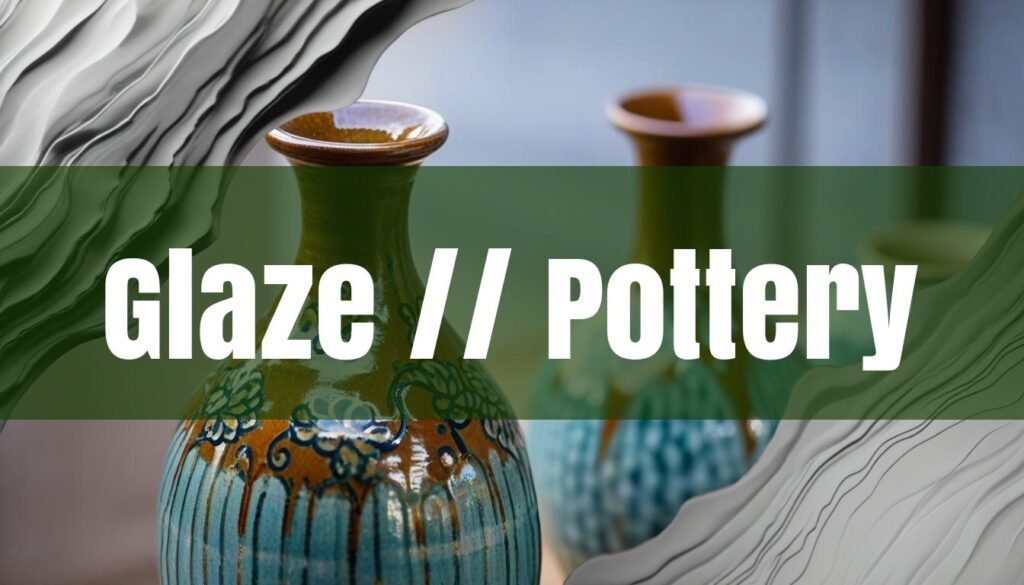Glazing pottery at home is an achievable and rewarding experience for hobbyists and beginners alike. It allows you to add a personal touch to your ceramic creations, enhancing their aesthetic appeal and functionality. This guide will provide you with a comprehensive overview of how to glaze pottery at home, from selecting the right materials to troubleshooting common problems.
Choosing the Right Clay and Understanding Firing Temperatures
The foundation of a successful glazing process lies in selecting the appropriate type of clay for your project. Different clays have varying firing temperatures and react differently to glazes. Understanding these properties is crucial for achieving the desired results. There are mainly 3 types of clay that are used to make pottery:
- earthenware
- stoneware
- porcelain
For more information on this topic, you can read a Kiln Firing Chart (https://www.kilncontrol.com/blog/kiln-firing-chart/)
Earthenware clay is a commonly used type of clay that is easy to work with, with a relatively low firing temperature, typically between 1,800 and 2,200 degrees Fahrenheit. Learn more about this clay type and it’s temperatures The most common low-fire clay body is earthenware, which is highly plastic (easily worked) and typically won’t shrink, warp, or sag excessively. Terracotta is one of the most popular types of earthenware. Earthenware clay generally matures at a firing temperature of about 950°C and 1,100°C (or 1,745°F and 2,012°F). While Cone 04 is the average when firing earthenware, low-fire materials can be fired anywhere from Cone 015 up to Cone 1.
Stoneware clay is stronger and more durable than earthenware clay and is often used to make objects such as cooking pots, vases, and sculptures. Find out more about stoneware clay This type of clay has a higher firing temperature than earthenware clay, typically between 2,300 and 2,400 degrees Fahrenheit. Typically, mid-range clay is stoneware, a plastic clay that is often grey when moist. Stoneware is typically combined with other clays to modify it, such as ball clays which might be added for plasticity. For mid-range material, a kiln should be firing at a temperature between 2124℉ and 2264℉ (1162-1240℃). Stoneware clay does not have the same porosity as earthenware clays, and so is perfectly suited to making pottery for holding liquids and foodstuffs.
Porcelain clay is the strongest and most durable of all types of clay, but it is also the most difficult to work with, and it requires a high degree of skill and expertise to shape and form. More information on porcelain clay The highest firing temperature clay is porcelain clay which is fired at temperatures between 2,400 and 2,600 degrees Fahrenheit. The clay bodies that require the highest firing temperatures are kaolin clays, which are most commonly used for porcelain. While pure kaolin fires to maturity at 3272℉ (1800℃), most porcelain should be fired between 2381℉ and 2455℉ (1305℃ and 1346℃) for best results.
Essential Safety Precautions for Glazing
Safety is paramount when working with glazes due to the potentially harmful chemicals they contain. When you working with glaze, you should always wear gloves, goggles, and plastic apron. Ensure good ventilation in your workspace to minimize inhalation of dust and fumes. A fan or open windows reduce dust accumulation. If possible, mix in a spray booth or under local exhaust ventilation. When glazing, refer to these safety guidelines
It is important to wear a HEPA filter mask that fits well when mixing clay or cleaning the studio, and to avoid excessive dust exposure. NIOSH N95, P100 or higher respirator whenever measuring or mixing dry powders.
Always clean studio often with a wet mop, wetvac, or a vacuum equipped with a HEPA filter, and never sweep your studio. Be sure to always clearly mark what’s inside and any hazards, such as “Barium-containing—Handle with Care”. Suppliers provide SDS docs that list toxicity and safe handling instructions, and you should keep them on hand for reference. Don’t pour leftover toxic glazes down the drain. Let them evaporate into a solid, then check local regulations for hazardous material disposal. Remember to always practice safety when glazing. You can also read this guide to pottery safety to learn more.
Beginner-Friendly Glaze Recipes
Creating your own glazes from scratch can be a cost-effective and rewarding way to achieve unique and personalized results. This is especially true when you are making large ammounts of pottery, or doing pottery professionally, as buying glaze can get quite expensive. Here are a few simple, reliable glaze recipes that are suitable for beginners, using readily available materials and equipment:
Here are five ingredients that are recommended: Nepheline Syenite, Whiting, Frit 3134, EPK, and Silica. It’s generally worth adding 1-2% to most glazes to improve the mix and application properties of the glaze without affecting the chemistry much. A simple glossy clear base, that should work well with colourants to make a solid glossy colour. For glaze recipes, see this glaze guide
This video shows a fun and easy Halloween-themed pottery project. It’s a great example of how to glaze pottery for a unique look.
The main colourants to start with are: Titanium (white/opacifier), Cobalt Carbonate (mainly blue), Copper Carbonate (mainly green), Red Iron Oxide (mainly red/brown), Manganese Dioxide (mainly orange/red), Chromium Oxide (mainly green), Tin Oxide (white, but pink/purple with Chromium) and Zirconium (white/opacifier). When creating colored glazes, experiment with a variety of colors to achieve the best look.
Glazing Techniques for Home Pottery
The application method significantly affects the final appearance of the glazed piece. Here are several glazing techniques suitable for home use, along with their advantages and disadvantages:
- Dipping is the easiest way to cover pottery and is done by most at some point. This form of glazing will give the finished piece a smooth look and fine texture. You can either dip your piece into the glaze twice as a base layer before decorating, or, to achieve a more solid look, you can dip the piece more often to create a thicker layer.
- By flowing the glaze over the piece that you plan on firing, you are working on the pouring glazing method. As you pour, the piece will absorb some of the glaze creating an even layer on the interior and exterior of the piece. With the style of dripping, you aren’t trying to cover the whole piece.
- Brushing can be used as both a base layer and for decorating. Picking the right brush size is important, large, flat brushes are great for larger pieces, and small, round-tip brushes are better for patterns or designs. You’ll want to have a good amount of glaze on your brush as you paint to avoid streaks in the glaze on your piece. You also want to take into consideration different brush stroke directions, for example, if you paint your first layer of glaze horizontally, you’ll want to paint vertically for the next layer and so on.
Explore different pottery glazing techniques and figure out which one you prefer. For more ideas, you can also read this guide to glazing techniques.
Troubleshooting Common Glazing Problems
Glazing imperfections can occur even with careful application. Here are troubleshooting tips and solutions for addressing common glazing problems that may arise during home firing:
- Fine cracks showing in the surface of the glaze is called crazing. Crazing is caused by mismatch of glaze and body thermal expansions. To fix crazing, increase the body expansion, fire the body to a higher temperature, or soak the body for longer time at the peak temperature.
- Pinholes in the glaze after firing are caused by development of gases from the body and/or glaze during firing. Pinholes in the glaze can be caused by under firing of the body, air trapped in the clay, or over application and over firing of underglaze colors. To fix pinholes, fire body to recommended firing temperature, wedge the plastic clay thoroughly, or reduce the application of underglaze colors.
- Bare (unglazed) patches on the surface of pottery are called crawling, which is glaze forming small islands. Crawling can be caused by excessive handling of dry clay ware before glazing, oil, grease, dust on ware before glazing, or cracking of the glaze layer during drying and before firing. To fix crawling, minimize the handling of the bisqueware before glaze application, keep the bisqueware clean, or handle dipped ware very carefully; reduce the clay content of the glaze.
If you are running into glazing issues, reference this fact sheet





